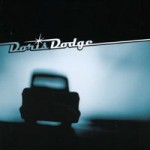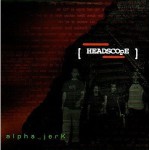 Doris Dodge
Doris Dodge
Doris Dodge
Self-Produced
Doris Dodge have been together for a little over a year now, presenting a straight-forward, Folk-tinged form of Rock. Formed from the remnants of the band Foma, singer and rhythm guitarist Jamie Kaineg and drummer Brian Smith initially secured the services of bassist Brent Williams (drummer/producer Greg Williams’ brother, formerly of Lodestar), but he later left the band, before the tracks submitted here were recorded.
Lead guitarist Maria Callahan was added to the line-up as well. Curiously enough, Callahan was a founding member of Doris Daze. So the band name is particularly apt. Doris Dodge, however, is named after Kaineg’s trusty Dodge automobile. Here, Callahan is utilized in purely a backup role, playing 12-string guitar on some tracks, while contributing superb backing vocal harmonies. Kaineg wrote or co-wrote all of the half-dozen songs presented on this EP
In addition, for the purposes of this recording, Kaineg and Smith enlisted former Foma lead guitarist Ben Brown, as well as guitarist Scott Weddle from the Flat Irons. Mike Yake, who helped to produce the project, played bass on five of the six tracks included. Doris Dodge have since added Eric Nichols as the permanent band bassist.
The first cut, “Sweet & Pure” is a pretty ballad. Kaineg’s voice is somewhat reminiscent of Aimee Mann, in her earlier days— when she was still heavily leaning upon Chrissie Hynde’s vocal mannerisms. Callahan’s 12-string guitar mingles with the alternating Major 7th chords of Kaineg’s rhythm guitar, while Brown furnishes lilting Country-flavored sonorities, reminiscent of some of Neil Young’s early guitar work. A powerful chorus, with Callahan providing strong high vocal harmonies, helps to solidify Kaineg’s charmingly simple sonic conception
A haunting, Mexicali theme pervades “Ophelia.” Brown’s succinctly subtle guitar machinations help to lend Kaineg’s plaintive tale increased tensility. Again, Maria’s harmonies create dimension for Jaime’s dusky alto vocal delivery: who, at times here, calls to mind a post-nodal Stevie Nicks.
But the true hit of this set is the gripping intensity of “Scar.” Weddle’s brooding guitar sets the dark mood as Jamie enters the scene with a cracked, croaking voice that could easily pass for Johnette Napolitano and Concrete Blonde. Jamie softens the second verse by singing an octave higher; such, that by the lovely chorus, where Kaineg displays a very compelling upper register, Aimee Mann is again a comparison. “It should have never come to this/We’ve gone too far/Will we take this chance?/Or are we afraid it’s gonna leave a scar?” Brilliant and brilliantly rendered.
“Let’s Go” is a dusty Folk number that again hearkens to Neil Young in his “Cowgirl In The Sand” period. Callahan’s electric 12 string guitar filigrees and mournful slide guitar wails give the song a cactus desert, sunbleached steerskull sense of detail.
Weddle etches a memorable guitar figure onto the 12/8 march of “Sink Or Swim,” where Jamie displays a fine vocal range and a knack for comely melody. “So Rememberin’ Him” could easily be taken from the Natalie Merchant/10,000 Maniacs songbook. A loping, arrangement, accompanies a gypsy melody, certainly worthy of Merchant, for what that might be worth.
Jamie Kaineg evinces enormous talent as a vocalist. Her voice is richly evocative, warm and alluring. While her songwriting shows occasional bright spots (especially “Scar”) there is not always enough substance in the material to sustain interest.
Not every musician is gifted with a fine voice and the ability to write great songs. Generally, both crafts require great amounts of time and application in order to succeed. At some point Kaineg may have to look outside her own oeuvre in order to secure material worthy of her voice. Certainly Callahan could be an invaluable ally in the songwriting department. Her experience as a songwriter could benefit Kaineg somewhat in developing her abilities. Or perhaps a songwriting partnership…? Whatever the case, it seems certain that we will be hearing more from Jamie Kaineg and Doris Dodge in the future.
 Rally Boy
Rally Boy
Hooks & Crutches
Jealous Butcher Records
Rally Boy have been around the local scene for a few years, slowly garner ing attention for their AltRock sounds; drawing comparisons to the likes of Big Star and Yo Lo Tengo, while making a splash performing at a recent CMJ conference. With three songwriters in the band, the Boys are loaded with diversity and the sort of DIY spirit that made stars of Stephen Malkmus and Pavement.
Rally Boy are nothing, if not versatile, varying their attack from song to song on this six-song EP. They start things off with the rousing anthem “Undrest.” The churning blustery guitars of Dan Blaker and Ryan Matheson kick the song off, with a moaning riff akin to that found on the Breeders’ “Hammer.” But soon the song unfolds, sounding like Green Day doing a ‘60s Who tune. Jagged powerchord shards play against arpeggiated notes, creating a powerful and melodic guitar onslaught. The song is a tale about misplaced commitments and love gone awry. The band makes the declaration “When your dress falls down/I want to be the one who’s standing there” sound like a pitiful request for solidarity in the face of infidelity. Still, it’s a brilliantly wrought piece of work.
Taking another tack altogether, “Stuck” finds Justin Scott turning out a bouyant bassline, propelling the song in a soulful style over the relentless chugging train that drummer Bob Ham engineers. it’s as if Squeeze met Pavement to do a Creedence Clearwater song. Through the verses, Scott’s “The Check-Out” is vaguely reminiscent of a Cure song, with guitars flitting like rain on a windshield. However, the song magically explodes in the chorus, with hard crunching chords accenting melodic vocals. Cool.
Blaker adds a fluttery clarinet to transitional sections of “Low E,” as a soaring guitar swirls atmospherically around chunky rhythm guitar, while Ham bashes out accents on a garbage can lid. Somehow, it all works. “Slang-Tips” is more angular and aggressive than the other tracks, purportedly a “paranoid rant about linguistic purity” (whatever the hell that’s supposed to be), it is, in reality, simply an excuse for the boys to go off for a couple of minutes.
The band redeems itself however, with “Submarine,” a tune reminiscent of the work of Semisonic— quirky, heartfelt and melodic. The secret extra track is a madcap little number with racing Spanish guitars and an off-kilter ‘60s sensibility and a story line that may or not involve necrophilia. But hey, it’s all in fun. “It’s all so obvious, why didn’t I suspect/It must be supernatural attraction.”
Rally Boy are definitely a cut above the average bar band. Their musicianship is tight . Their approach is simple, straightforward and absolutely to the point. Continued improvement in their songwriting will bode well for this likable foursome, for whom the future seems bright, indeed.
 Distracted
Distracted
Episode
Self-Produced
Here’s an enterprising young quartet who exhibit a lot of potential, having gathered influences from some of the Post-Grunge movement’s finest purveyors. Distracted display a propensity for heavy, executing their parts with guillotine-like efficiency.
Recalling, perhaps slightly, Pearl Jam’s “Jeremy,” “Shane” is the tale of a physically abused kid, punctuated by the blistering guitar attack of vocalist Gavin Wells and lead guitarist Ario Lynch. Lynch’s subdued solo in the middle, gives evidence of taste and restraint. Offspring and Sponge also come to mind as possible influences, as well.
Over Greg Nibler’s heavily flanged bass, Wells intones the vocals on “Salvation,” a song that starts out quietly enough, before exploding into the second verse. Stone Brooks’ sure-handed drumwork helps to secure the foundation while Lynch provides the overdriven guitar pyrotechnics.
“Down Here’ begins as a poignant ballad, that slowly gathers momentum through the verses, finally resolving into the expected fury , a full three minutes into the song. A nicely developed piece of work. “Temporary Minds” too, slowly builds in intensity, as Brooks artfully maintains a treacherously 11/8 time signature underneath the moaning and crying guitars of Lynch and Wells, before resolving in 12/8 time, which seems straight-ahead in comparison with the frenetic pace of the first half of the song. Very nice.
Distracted exhibit solid musicianship throughout the six songs submitted here, proving that they are more than merely the sum of their influences. Wells, especially, distinguishes himself as a vocalist and songwriter, while the other members help to flesh out the nuances the songs provide. As the band grows and matures, it would seem they would elevate the level of their songwriting as well. They have a good start. Ii will be interesting to see where they take it from here.
 Dead Poets Society
Dead Poets Society
The Electric Haze
Self-Produced
Have you ever heard of Sonic Foundry? Well Dead Poets Society have. And that combination proves the old adage: “A little software is a dangerous thing.” Afforded a modest library of Sonic Foundry loops, this trio entertain visions of Techno grandeur.
As such, this recording stands as a great demonstration of what beginners can do with the Sonic Foundry software. This project sounds good. And, while painfully awkward in places (some transitional passages, especially), there is some reason to believe that these novices will develop further, perhaps to the extent that they can eventually create something original on their own.
The problem lies in the fact that the three culprits here: Wa, ostensibly playing percussion and keyboards, while doing the “songwriting” and some of the programming; Raven Nightshado, who apparently adds more keyboards, as well as the ever popular “artistic mutilation”— and Tim Gibson (somehow his name seems out of place in this setting), who plays, yes, keyboards and “all things stringed.” Presumably that would include some of the bass sounds and the guitar— which makes occasional appearances throughout the proceedings, and distinguishes itself among much of the pre-recorded, sampled loop brouhaha.
Not so successful are the frail attempts at universality and “world consciousness,” wherein the lads hopscotch haphazardly through some long-revered musical cultures, as if they were pulling plates of musical unagi off the conveyor at Sushi World, constructing nada.
On the positive side, Mr. Wa seems somewhat adept at pasting together viable drum loop sequences, upon which the others layer all this other stuff. And, as mentioned, Tim Gibson seems to have some command of the guitar, and possibly the bass. It is unclear at this time as to whether Mr Nightshado’s “artistic mutilation” are part of the problem or the solution.
But the problem, and this is a tip to all you kids out there experimenting with these loop packages available at a music store near you: if you use the sounds right out of the box, without tweaking them or editing them or somehow making them “yours,” or otherwise fairly unrecognizable, your material is going to sound just like all that other stuff submitted to the Sonic Foundry website, where, no doubt, the Dead Poets Society have, from time to time, reigned supreme.
These very same loops can be heard in countless television and radio advertisements— always altered to the point of near imperceptibility, which would seem to be the point, after all. To just throw a few of these loops together over a frenetic (and, generally) sampled beat and bassline is practically void of any real imagination, but merely an exercise in computer programming, while cutting and pasting together chunks of musical information. One could hire other people to do the fill in work for him. “Uh, throw that Asian thing there. The tabla and sitar there. Segue to a frenetic beat and bassline and… cut it. Maybe toss in a piece of Grieg’s ‘In The Hall of the Mountain King,’ to display our Classical training. I’m off to the gym.”
In order for the Dead Poets Society to progress, they need to truly learn how to play instruments, whereby they might learn valuable lessons in harmony and dynamics, which will enrich immensely their palette of musical colors and textures. Secondarily, the employment of loops can be extremely effective, but it is imperative that the samples and loops are original, or at the very least unique in the acquisition of their source material (even if its bought or stolen), or modified in a singular or original way.
There’s nothing wrong with what the Dead Poets Society do. They appear to have their cadre of fans and followers, but those people somehow seem simply misguided or uninformed. As Abraham Lincoln once said, “You can fool some of the people some of the time…”
 Headscope
Headscope
alpha_jerk
Self-Produced
Now this is more like it! Here is a band that uses aspects of Electronica to its best advantage, creating atmospheric moods that absolutely crackle with intense originality. The difference here is that there are true musicians in this band, in the respect that they really know how to play instruments, as well as to how operate equipment that generates sounds, which they also do quite well.
Not the least of these musicians is vocalist Krys No, whose notable feat is to manage to keep up with the dense sound sculptures created by Kevin Ellis on keys and guitar, and Niall Davids, who contributes bass along other effects. Ellis handles the sampling while Davids does the programming. Drummer Allen Brown holds it all together, laying down solid, rhythmic underpinnings, often in conjunction with pre-programmed rhythm tracks.
“Sundown” kicks off the set, driven by stuttering arpeggiated keyboards and electronic sounding drums, as No enters the sonic picture wailing girlishly, like Belinda Carlisle doing Bjork. An interesting combination. Middle Eastern themes run through the shadowy “Bird In A War.” Ellis’ warbling keyboard, is motivated by Brown’s powerfully insistent drums and the subtle sound hand percussion (although it may be electronically generated), while Krys’ shouts echo in the abyss.
Alannis Morissette is No’s obvious vocal inspiration on the live rendition of “Casseopia.” Brown’s electronic kit generates the percussion on “Lung Candy,” a great live electronic piece. “509” moves in a completely different direction, with brash snarling guitars galloping ahead as Krys screams out in the din. But hidden veers more toward straight electronica, with a variety of keyboard tones generating the ambience. No handles the vocal chores admirably, inflecting the melody with mysterious, vaguely Eastern intonations and slippery falsetto, before facing Mecca, shrieking as the scene melts around her.
With simple, more mainstream piano accompaniment and muted synth strings, “Good Day” is a winning number, something of a departure from typical Headscope fare. “My Friend Stephanie” is one of the highlights of the dozen songs presented on this album. Brown’s hard-hitting drumwork provides the foundation, as No delineates a tale, quoting Bill Withers along the way. More straight ahead. More accessible. Krys scats mercilessly, screaming at the top of her lungs, reminiscent of Portland punk legend Monica Nelson. With slow deliberation, great clouds of vibrato guitar darkly gather, to bring the song to a gradual halt.
An indistinct Celtic feel spins the jig “Knee Deep.” Krys weaves a lovely falsetto, ala Sinead O’Connor, as Ellis’ synth drips and drops in long legato phrases over jangling electric rhythm guitar. Also very nice. The familiar descending chromatic, minor-key electric piano figure of “Real Life Movies,” nearly identical to that found on Harry Nilsson’s version of “One,” serves as another fine source of inspiration for No’s spirited ululations, at times sounding a bit like Jewel, of all people, and at other times like Nilsson himself.
Returning to the big beat, “The Road” compels Krys to resume her more abrasive attack mode, here recalling Debbie Iyals of Romeo Void, as Davids hammers out Tony Levin-style low end over Brown’s inspired jungle drumming. Heavy. Conversely, “Down On You” travels upon a strange techno disco beat and Ellis’ jagged organ-tone accents and funky rhythm guitar.
Headscope prove that there are still new places to take the Techno ride. Krys No demonstrates very real talent that is well short of reaching its peak. If she can overcome her periodic propensity for vocal harshness and occasional departures in pitch (generally on the more technically challenging of the arrangements), she could become a great singer.
The rest of the band concocts consistently delicious settings for No’s adventurous perambulations, varying their approach from song to song with concordant aplomb and resplendent serendipity. Their sound is original and extremely tight, exploring a variety of styles with expert acuity. We can all look forward to hearing more from this very thoughtful new band.
